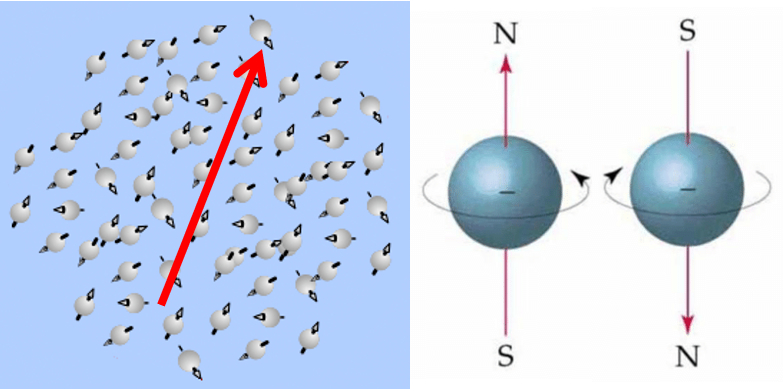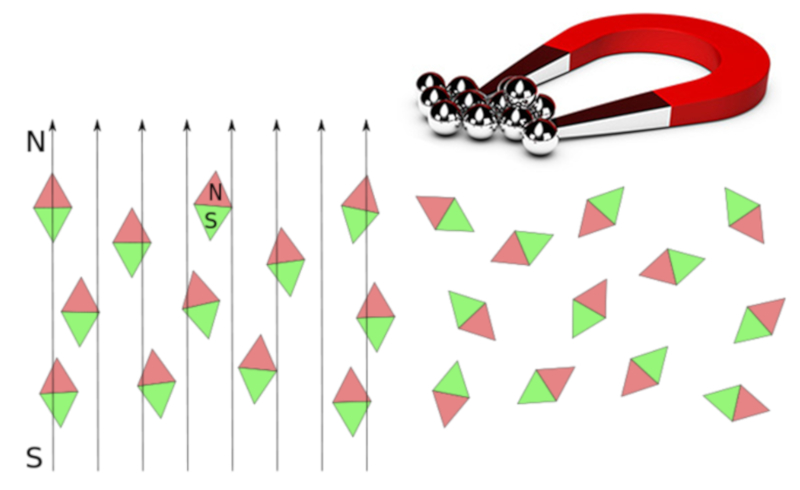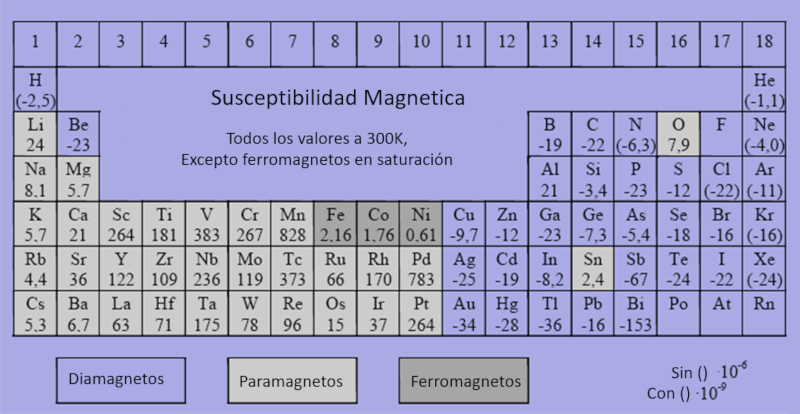Paramagnetismo
Storyboard 
Paramagnetics are materials that under an external magnetic field polarize creating their own magnetic field. However this is not permanent, that is to say when they are removed from the external field they return to a state of magnetic depolarization.
ID:(488, 0)
Magnetization
Definition 
Paramagnetism describes a behavior in which materials can be magnetized based on an applied external magnetic field. In this sense, they do not remain magnetized and lose this property as soon as the external field is removed.

Materials with paramagnetic properties include magnesium, molybdenum, lithium, and tantalum.
ID:(12106, 0)
Paramagnet
Image 
Paramagnetism describes a behavior in which materials can become magnetized in response to an applied external magnetic field, but they do not retain the magnetization when the external magnetic field is removed.

Paramagnetism originates from three types of magnetic moments:
• The magnetic moment of the nucleus (denoted as $\mu_n$)
• The magnetic moment of the electrons (denoted as $\mu_s$)
• The magnetic moment resulting from the motion of electrons in the orbitals (denoted as $\mu_l$)
The first of these magnetic moments is generally much smaller than the other two and is often negligible. The total magnetic moment of the electron ($S$) and orbital ($L$) magnetic moments can be calculated using the formula:
$\mu_{L+S}=\sqrt{4S(S+1)+L(L+1)}\mu_B$
where $\mu_B$ is the Bohr magneton.
ID:(12107, 0)
Ferro, para and diamagnetic materials
Note 
Every element can be classified as ferromagnetic, paramagnetic, or diamagnetic with varying levels of magnetization sensitivity. Elements that are ferromagnetic, paramagnetic, or diamagnetic can be identified based on their magnetic properties, and it's important to use the appropriate scales when working with these values.

For general data on these classifications, additional resources can be consulted at: Datos.
ID:(12117, 0)
Paramagnetismo
Description 
Paramagnetics are materials that under an external magnetic field polarize creating their own magnetic field. However this is not permanent, that is to say when they are removed from the external field they return to a state of magnetic depolarization.
Variables
Calculations
Calculations
Equations
(ID 12109)
Examples
Paramagnetism describes a behavior in which materials can be magnetized based on an applied external magnetic field. In this sense, they do not remain magnetized and lose this property as soon as the external field is removed.

Materials with paramagnetic properties include magnesium, molybdenum, lithium, and tantalum.
(ID 12106)
Paramagnetism describes a behavior in which materials can become magnetized in response to an applied external magnetic field, but they do not retain the magnetization when the external magnetic field is removed.

Paramagnetism originates from three types of magnetic moments:
• The magnetic moment of the nucleus (denoted as $\mu_n$)
• The magnetic moment of the electrons (denoted as $\mu_s$)
• The magnetic moment resulting from the motion of electrons in the orbitals (denoted as $\mu_l$)
The first of these magnetic moments is generally much smaller than the other two and is often negligible. The total magnetic moment of the electron ($S$) and orbital ($L$) magnetic moments can be calculated using the formula:
$\mu_{L+S}=\sqrt{4S(S+1)+L(L+1)}\mu_B$
where $\mu_B$ is the Bohr magneton.
(ID 12107)
Every element can be classified as ferromagnetic, paramagnetic, or diamagnetic with varying levels of magnetization sensitivity. Elements that are ferromagnetic, paramagnetic, or diamagnetic can be identified based on their magnetic properties, and it's important to use the appropriate scales when working with these values.

For general data on these classifications, additional resources can be consulted at: Datos.
(ID 12117)
La energ a magn tica de un tomo
| $ \epsilon =-\vec{ \mu }\cdot\vec{ H }$ |
en donde
(ID 3655)
El momento magn tico de un tomo es con igual a
| $ \vec{\mu} = g \gamma \vec{S} $ |
\\n\\ndonde \\n\\n
$\gamma\equiv\displaystyle\frac{e}{2m_e}=8.7821\times 10^{10} C/kg$
es el radio girosc pico, con
(ID 3656)
Si el campo esta en direcci n
| $ S_z = \hbar m $ |
con
(ID 12109)
El momento magn tico se puede expresa con momento magnético $C m^2/s$ and radio giroscópico $C/kg$ del orden de uno:
| $ \vec{\mu} = g \gamma \vec{S} $ |
Si el campo esta orientado en direcci n del eje z se puede reescribir con componente $z$ del spin $kg m^2/s$, constante de Planck dividia con $2\pi$ $J s$ and numero cuántico $-$ el spin
| $ S_z = \hbar m $ |
\\n\\ny con ello la energ a como\\n\\n
$\epsilon=-g\gamma\vec{S}\cdot\vec{H}=-g\gamma HS_z=-g\gamma\hbar Hm$
\\n\\nSi se introduce el magneto de Bohr como\\n\\n
$\mu_B=\gamma\hbar=\displaystyle\frac{e\hbar}{2m_e}=9.2613\times 10^{-24} C m^2/s$
se tiene que la energ a pueden asumir con componente $z$ del spin $kg m^2/s$, constante de Planck dividia con $2\pi$ $J s$ and numero cuántico $-$ los valores
| $ \epsilon =- g \mu_B H m $ |
(ID 3657)
Con la definici n de la funci n partici n para un sistema en que los elementos no se sobreponen con
| $Z=\displaystyle\sum_Re^{-\beta E_R}$ |
y los niveles de energ a est n definidos con campo magnético $C/m s$, energía del spin en el campo externo $J$, magneton de Bohr $C m^2/s$ and numero cuántico $-$
| $ \epsilon =- g \mu_B H m $ |
se puede escribir la funci n partici n para el sistema de
| $ Z =\left[\displaystyle\sum_{ m =- s }^ s e^{- \beta g \mu_B H m }\right]^ N $ |
(ID 3658)
Por analog a el campo magn tico cumple el rol de variable mientras que el momento magn tico la de una fuerza generalizada es con es
| $ \eta \equiv\displaystyle\frac{ g \mu_B H }{ k_B T }$ |
(ID 3661)
La suma de una expresi n del tipo\\n\\n
$Z=\displaystyle\sum_{m=-s}^s e^{-\eta m}$
\\n\\nse puede escribir como dos sumas desde 0 a -s y 0 a s restando el elemento 0 que se estar a sumando dos veces\\n\\n
$Z=\displaystyle\sum_{m=-s}^0 e^{-\eta m}+\displaystyle\sum_{m=0}^s e^{-\eta m}-1$
\\n\\nRealizando un cambio de variable (m>-m) en la primera suma se obtiene\\n\\n
$Z=\displaystyle\sum_{m=0}^s e^{\eta m}+\displaystyle\sum_{m=0}^s e^{-\eta m}-1$
\\n\\nDado que las sumas corresponden a series geom tricas finitas se tiene que\\n\\n
$\displaystyle\sum_{m=0}^s e^{\eta m}=\displaystyle\frac{1-e^{(s+1)\eta}}{1-e^{\eta}}$
\\n\\ny\\n\\n
$\displaystyle\sum_{m=0}^s e^{-\eta m}=\displaystyle\frac{1-e^{-(s+1)\eta}}{1-e^{-\eta}}$
\\n\\nlo que da\\n\\n
$Z=\displaystyle\frac{1-e^{(s+1)\eta}}{1-e^{\eta}}+\displaystyle\frac{1-e^{-(s+1)\eta}}{1-e^{-\eta}}-1$
\\n\\nComo\\n\\n
$\displaystyle\frac{1-e^{-(s+1)\eta}}{1-e^{-\eta}}-1=\displaystyle\frac{1-e^{-\eta s}}{e^{\eta}-1}$
\\n\\nla expresi n se puede reescribir como\\n\\n
$Z=\displaystyle\frac{1-e^{(s+1)\eta}}{1-e^{\eta}}+\displaystyle\frac{1-e^{-\eta s}}{e^{\eta}-1}=\displaystyle\frac{e^{(s+1)\eta}-e^{-\eta s}}{e^{\eta}-1}$
\\n\\nSi multiplicamos numerador y denominador por
$Z=\displaystyle\frac{e^{(s+1/2)\eta}-e^{-\eta (s+1/2)}}{e^{\eta/2}-e^{-\eta/2}}$
que se puede escribir con la funci n seno hiperb lico con como
| $Z=\displaystyle\frac{\sinh(s+\displaystyle\frac{1}{2})\eta}{\sinh\displaystyle\frac{1}{2}\eta}$ |
(ID 10727)
Con campo magnético $C/m s$, constante de Boltzmann $J/K$, factor $\eta$ $-$, magneton de Bohr $C m^2/s$ and temperatura $K$ el factor
| $ \eta \equiv\displaystyle\frac{ g \mu_B H }{ k_B T }$ |
la funci n partici n en este caso con campo magnético $C/m s$, factor $\beta$ $C m^2/s$, función de partición del paramagneto $-$, magneton de Bohr $C m^2/s$, numero cuántico $-$, numero cuántico máximo $-$ and números de partículas $-$
| $ Z =\left[\displaystyle\sum_{ m =- s }^ s e^{- \beta g \mu_B H m }\right]^ N $ |
se puede sumar con campo magnético $C/m s$, factor $\beta$ $C m^2/s$, función de partición del paramagneto $-$, magneton de Bohr $C m^2/s$, numero cuántico $-$, numero cuántico máximo $-$ and números de partículas $-$ dando
| $ Z =\left[\displaystyle\frac{\sinh( J +\displaystyle\frac{1}{2}) \eta }{\sinh\displaystyle\frac{1}{2} \eta }\right]^ N $ |
Por analog a el campo magn tico cumple el rol de variable mientras que el momento magn tico la de una fuerza generalizada.
(ID 3660)
Con campo magnético $C/m s$, constante de Boltzmann $J/K$, factor $\eta$ $-$, magneton de Bohr $C m^2/s$ and temperatura $K$ el factor
| $ \eta \equiv\displaystyle\frac{ g \mu_B H }{ k_B T }$ |
se puede definir una temperatura caracter stica con campo magnético $C/m s$, constante de Boltzmann $J/K$, factor $\eta$ $-$, magneton de Bohr $C m^2/s$ and temperatura $K$
| $ T_H \equiv\displaystyle\frac{ g \mu_B H }{ k_B }$ |
(ID 9553)
Como la energ a de un spin en un campo magn tico se puede calcular del momento magn tico
| $ \epsilon =-\vec{ \mu }\cdot\vec{ H }$ |
se puede asociar el campo magn tico con la variable generalizada y el momento magn tico con la fuerza generalizada. En tal caso se puede emplear la relaci n entre fuerza generalizada y funci n partici n con
| $\overline{X_i}=\displaystyle\frac{1}{\beta}\displaystyle\frac{\partial\ln Z}{\partial x_i}$ |
para calcular el momento magn tico medio se puede calcular mediante con :
| $\bar{\mu}=\displaystyle\frac{1}{\beta}\displaystyle\frac{\partial\ln Z}{\partial H}$ |
(ID 3662)
La derivada en el campo magn tico del logaritmo de la funci n con factor $\eta$ $-$, función de partición del paramagneto $-$, numero cuántico máximo $-$ and números de partículas $-$
| $ Z =\left[\displaystyle\frac{\sinh( J +\displaystyle\frac{1}{2}) \eta }{\sinh\displaystyle\frac{1}{2} \eta }\right]^ N $ |
con campo magnético $C/m s$, constante de Boltzmann $J/K$, factor $\eta$ $-$, magneton de Bohr $C m^2/s$ and temperatura $K$ la definici n
| $ \eta \equiv\displaystyle\frac{ g \mu_B H }{ k_B T }$ |
\\n\\nes\\n\\n
$\displaystyle\frac{\partial\ln Z}{\partial H}=\displaystyle\frac{\partial\ln Z}{\partial\eta}\displaystyle\frac{\partial\eta}{\partial H}=\displaystyle\frac{g\mu_B}{kT}\frac{\partial\ln Z}{\partial \eta}\equiv \displaystyle\frac{g\mu_B}{kT} B_s(\eta)$
donde con campo magnético $C/m s$, constante de Boltzmann $J/K$, factor $\eta$ $-$, magneton de Bohr $C m^2/s$ and temperatura $K$
| $ B_s(\eta) =\displaystyle\frac{1}{ s }\left[\left( s +\displaystyle\frac{1}{2}\right) \text{coth}\left( s +\displaystyle\frac{1}{2}\right) \eta - \displaystyle\frac{1}{2} \text{coth}\displaystyle\frac{1}{2} \eta \right]$ |
(ID 3664)
Como el momento de magnetizaci n medio se calcula con
| $\bar{\mu}=\displaystyle\frac{1}{\beta}\displaystyle\frac{\partial\ln Z}{\partial H}$ |
se tiene para la funci n partici n con factor $\eta$ $-$, función de partición del paramagneto $-$, numero cuántico máximo $-$ and números de partículas $-$
| $ Z =\left[\displaystyle\frac{\sinh( J +\displaystyle\frac{1}{2}) \eta }{\sinh\displaystyle\frac{1}{2} \eta }\right]^ N $ |
se tiene que con factor $\eta$ $-$, función de Brillouin de $\eta$ $-$ and numero cuántico máximo $-$
| $ B_s(\eta) =\displaystyle\frac{1}{ s }\left[\left( s +\displaystyle\frac{1}{2}\right) \text{coth}\left( s +\displaystyle\frac{1}{2}\right) \eta - \displaystyle\frac{1}{2} \text{coth}\displaystyle\frac{1}{2} \eta \right]$ |
el momento magn tico medio es con factor $\eta$ $-$, función de Brillouin de $\eta$ $-$ and numero cuántico máximo $-$
| $ \bar{\mu} = g \mu_B N B_s(\eta) $ |
(ID 3659)
En el limite de altas temperaturas el factor
$coth(x)\sim\displaystyle\frac{1}{x}+\displaystyle\frac{1}{3}x$
y la funci n con factor $\eta$ $-$, función de Brillouin de $\eta$ $-$ and numero cuántico máximo $-$
| $ B_s(\eta) =\displaystyle\frac{1}{ s }\left[\left( s +\displaystyle\frac{1}{2}\right) \text{coth}\left( s +\displaystyle\frac{1}{2}\right) \eta - \displaystyle\frac{1}{2} \text{coth}\displaystyle\frac{1}{2} \eta \right]$ |
tiende con factor $\eta$ $-$, función de Brillouin de $\eta$ $-$ and numero cuántico máximo $-$ a
| $ B_s(\eta) \sim \displaystyle\frac{ s +1}{3} \eta $ |
(ID 3663)
El momento magn tico con función de Brillouin de $\eta$ $-$, magneton de Bohr $C m^2/s$, momento magnético medio $C m^2/s$ and números de partículas $-$ es
| $ \bar{\mu} = g \mu_B N B_s(\eta) $ |
que en el limite de altas temperaturas, con factor $\eta$ $-$, función de Brillouin de $\eta$ $-$ and numero cuántico máximo $-$ en que
| $ B_s(\eta) \sim \displaystyle\frac{ s +1}{3} \eta $ |
y
| $ \eta \equiv\displaystyle\frac{ g \mu_B H }{ k_B T }$ |
se tiende con campo magnético $C/m s$, constante de Boltzmann $J/K$, factor $\eta$ $-$, magneton de Bohr $C m^2/s$ and temperatura $K$ a
| $ \bar{\mu} \sim \displaystyle\frac{ J +1}{3}\displaystyle\frac{ g ^2 \mu_B ^2 H }{ k_B T } N $ |
(ID 9559)
ID:(488, 0)
